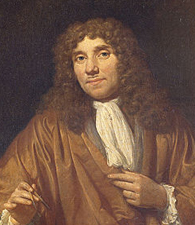The “Father of Microbiology,” Anton van Leeuwenhoek was not a trained scientist, yet he made some of the most astounding scientific discoveries of his time. He is credited with being the first to observe bacteria under his microscopes and discovering the cellular processes underlying sexual reproduction in animals.
Anton van Leeuwenhoek’s Early Days
Originally named Thonius Philipszoon, Anton van Leeuwenhoek was born on October 24, 1632. He probably got the second name from his place of birth, a house at the corner of Lion’s Gate, Delft, Netherlands. Van Leeuwenhoek literally means “from Lion’s Corner.”
The son of a basket maker father and a mother who came from a family of beer brewers, van Leeuwenhoek was expected to work as a tradesman as well, and was schooled accordingly. He never learned foreign languages, but did learn some basic math and science.
When he was 16, van Leeuwenhoek was sent to Amsterdam for six years to apprentice as a linen draper. It was here that he became fascinated with the magnifying lenses used to gauge fabric quality and thread count. Upon returning to Delft in 1654, van Leeuwenhoek married and opened his own fabric shop.
Sources in this Story
- University of California Museum of Paleontology: Antony van Leeuwenhoek (1632-1723)
- BBC Historical Figures: Antonie van Leeuwenhoek
- Molecular Expressions: Museum of Microscopy: The Leeuwenhoek Microscope
- Essential Vermeer: Antonie van Leeuwenhoek
- The Brian J. Ford Web Site: The Leeuwenhoek Specimens
Van Leeuwenhoek’s Notable Accomplishments
During a 1668 trip to London, van Leeuwenhoek probably saw a copy of Robert Hooke’s “Micrographia,” a book that included descriptions and pictures of what the English scientist saw through various lenses.
Around that same time, van Leeuwenhoek used one of his microscopes to examine chalk from the cliffs at Kent. For the next several years, van Leeuwenhoek continued his hobby of creating stronger lenses and examining the world around him. There was little he would not study: His saliva and feces, water from nearby canals, small insects and their parts were all fair game.
Van Leeuwenhoek was not the first person to work with or invent a microscope, nor was he using the most advanced technology available at the time, the compound microscope. What he had on his side was his skill working with glass, which he used to make stronger and clearer lenses than were available anywhere else. Much of his lenses’ power is attributed to his skill at polishing and grinding, but scientists have recently begun to believe he blew small globes of glass into very small, very strong lenses, which he then mounted on a small piece of metal. The lens was adjustable and the specimen was fixed on a spike. The instrument required very bright light and patience to operate but, when used correctly, van Leeuwenhoek’s microscopes could magnify up to 200 times what the naked eye could see.
A physician from Delft noticed van Leeuwenhoek’s studies and in 1673, penned a letter detailing the cloth merchant’s discoveries to the Royal Academy in London. They were fascinated and van Leeuwenhoek continued a correspondence with the Academy over the next 50 years. In 1675, while examining a peppercorn under one of his microscopes, he observed small microorganisms swimming in the water. His letter to the Royal Academy revealing this discovery made waves throughout the scientific world, which initially doubted the discovery of such small life forms.
Several years later, in 1680, van Leeuwenhoek was elected a fellow of the Royal Academy and his fame spread. He continued his discoveries, identifying bacteria, blood cells, nematodes and plant anatomy. He discovered spermatozoa in human semen, and during his 40 subsequent years of study, discovered how sperm cells penetrate egg cells in order to accomplish fertilization.
The Rest of the Story
Van Leeuwenhoek was known as a very kind man, one who tried not to harm any living creature, even in the pursuit of scientific discovery. He was elected to a minor city office in Delft, chamberlain to the sheriffs, a title that he held for 39 years.
One of the major questions about van Leeuwenhoek’s personal life is the extent of his relationship with Dutch painter Johannes Vermeer, who also hailed from Delft. The only documented evidence of the two’s knowledge of each other is paperwork stating that van Leeuwenhoek was the executor of Vermeer’s estate when he died away in 1675. However, many believe he was the model for Vermeer’s famous paintings, “The Geographer” and “The Astronomer.”
Van Leeuwenhoek himself died at the age of 90, on August 20, 1723, in Delft. After his death, his daughter sent 26 of his microscopes to the Royal Academy. In 1981, a British scientist, Brian J. Ford, found some of van Leeuwenhoek’s original specimens and he was able to examine and report on them.
This article was originally written by Jennifer Ferris; it was updated October 24, 2017.











